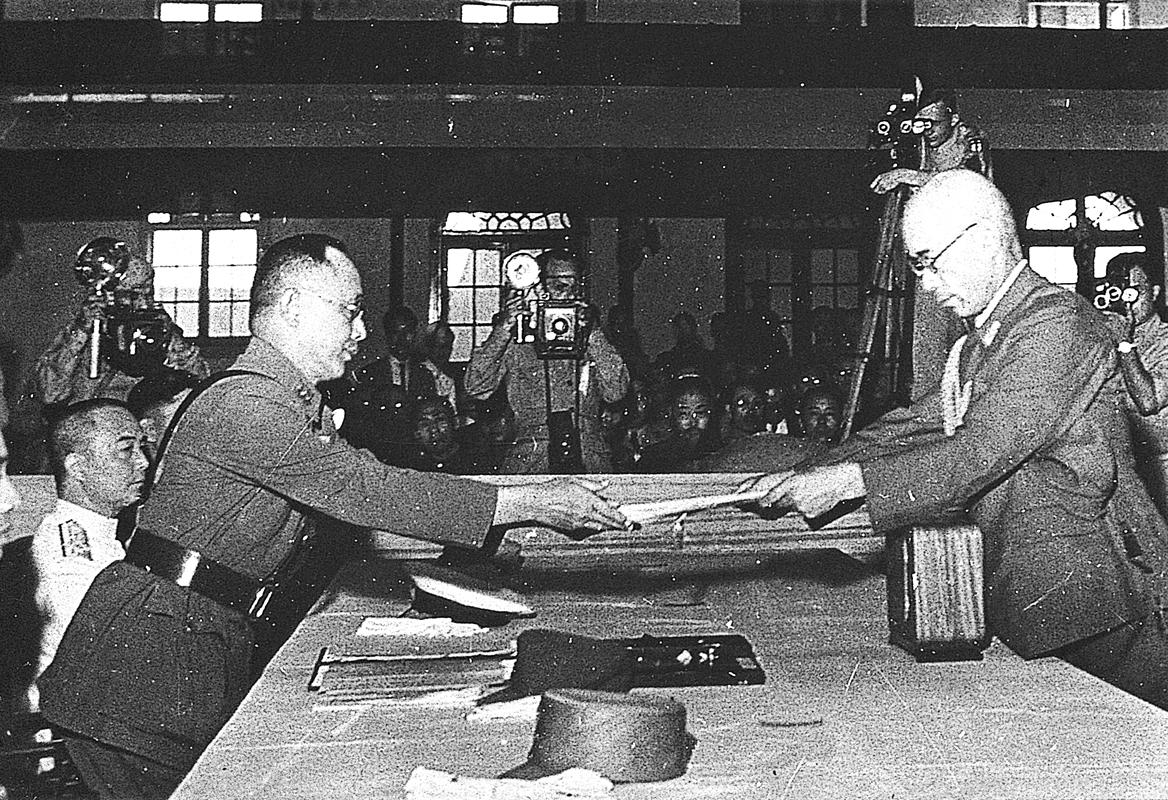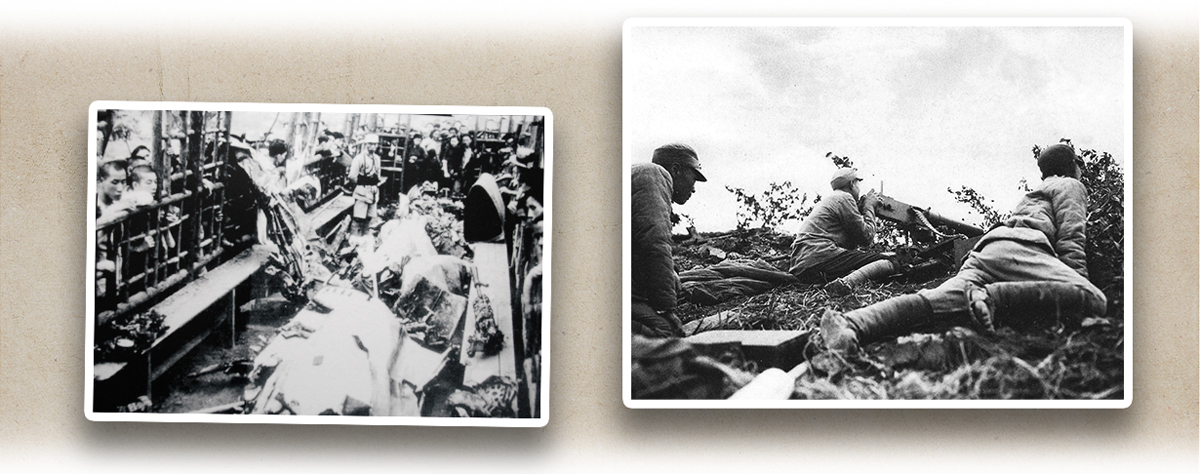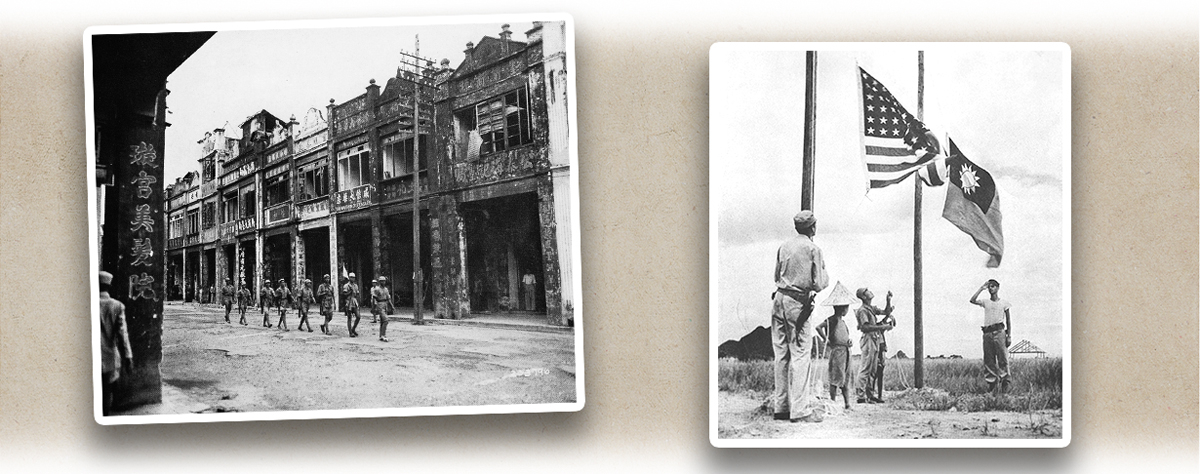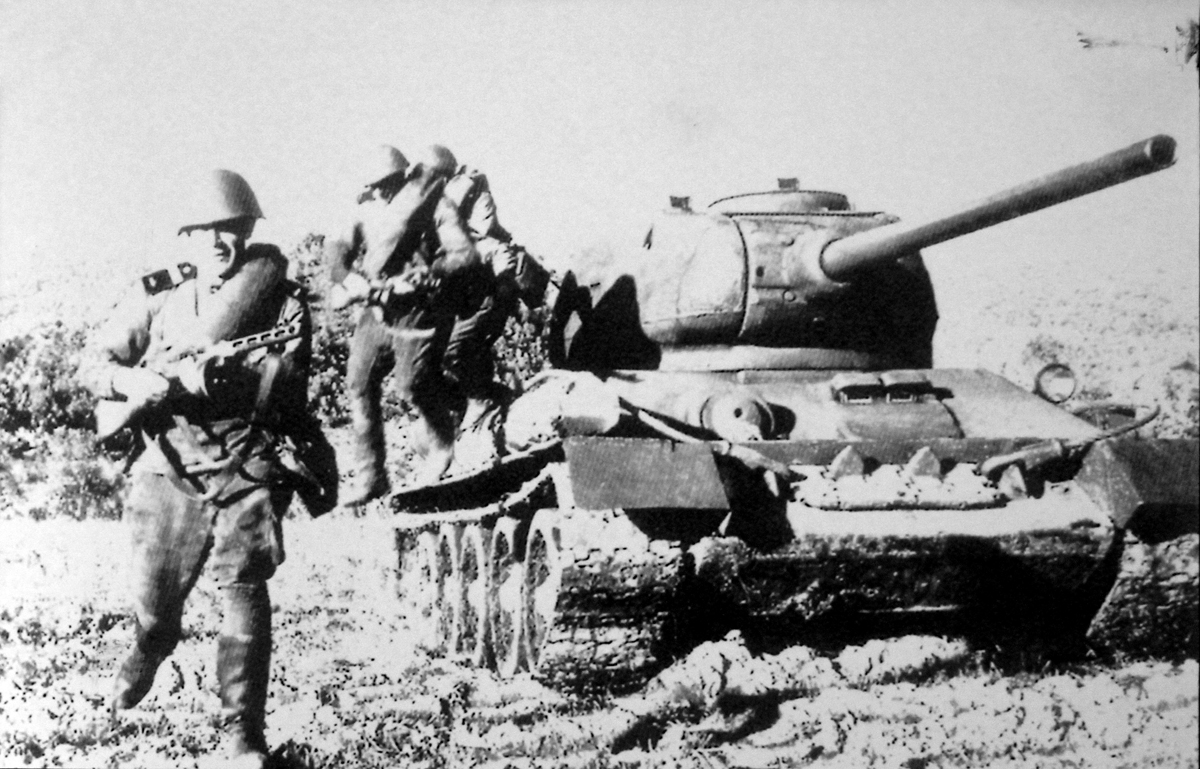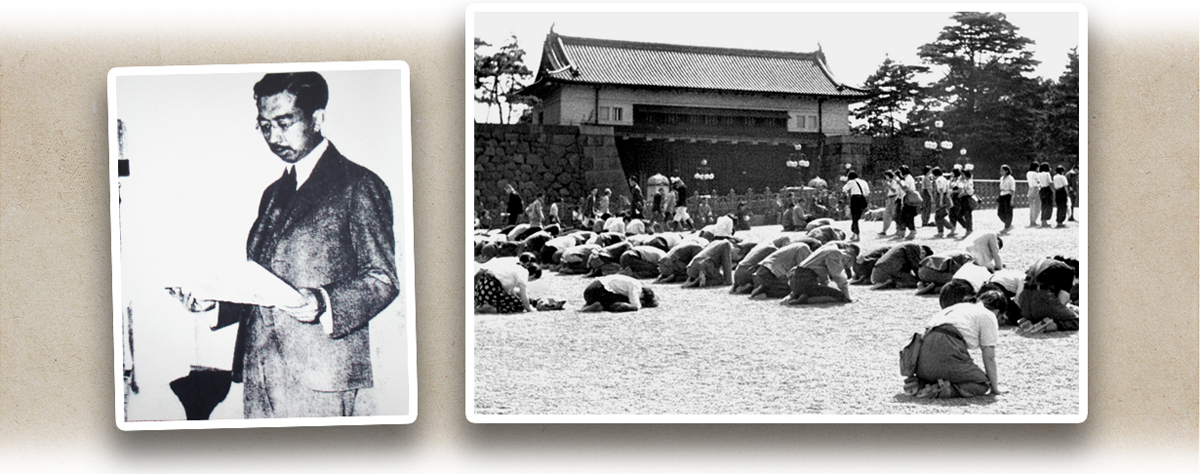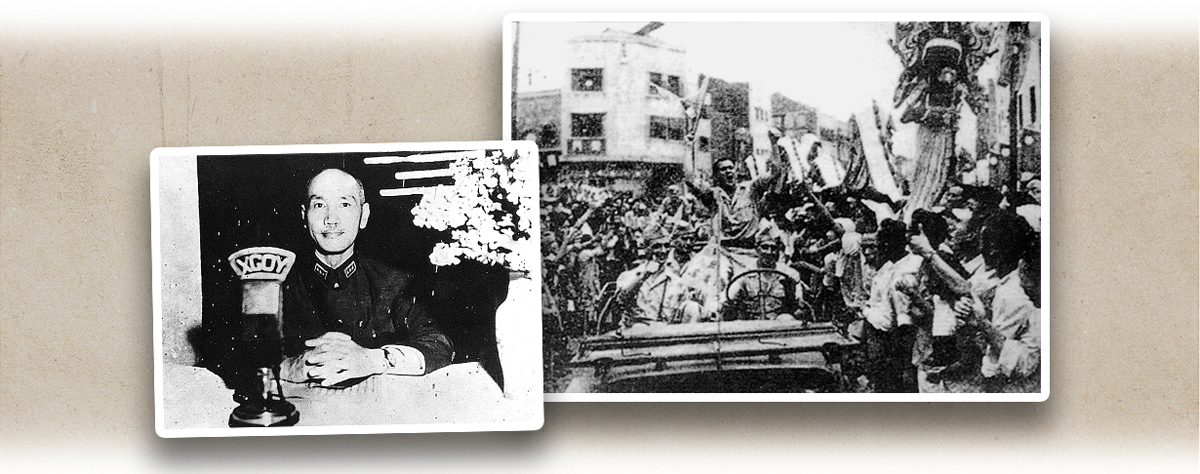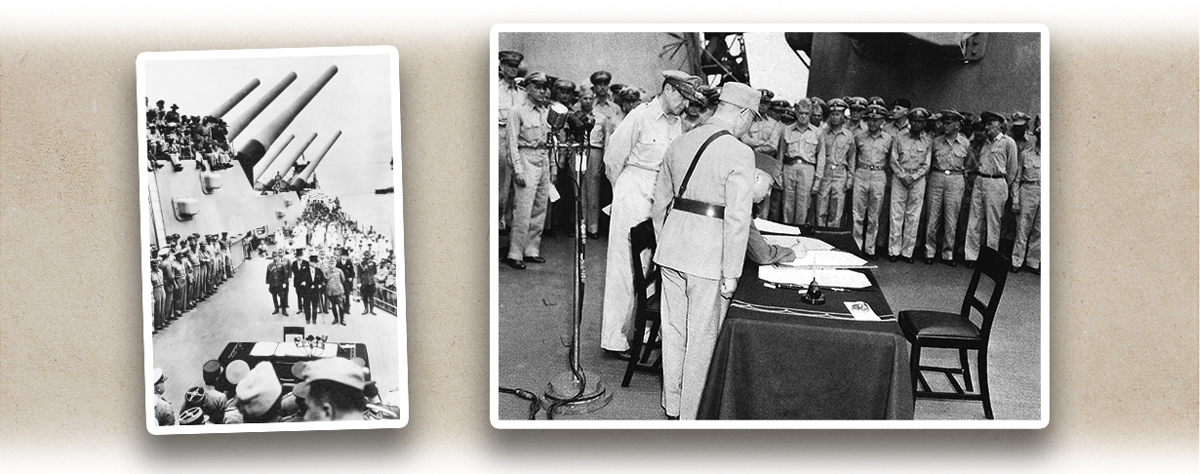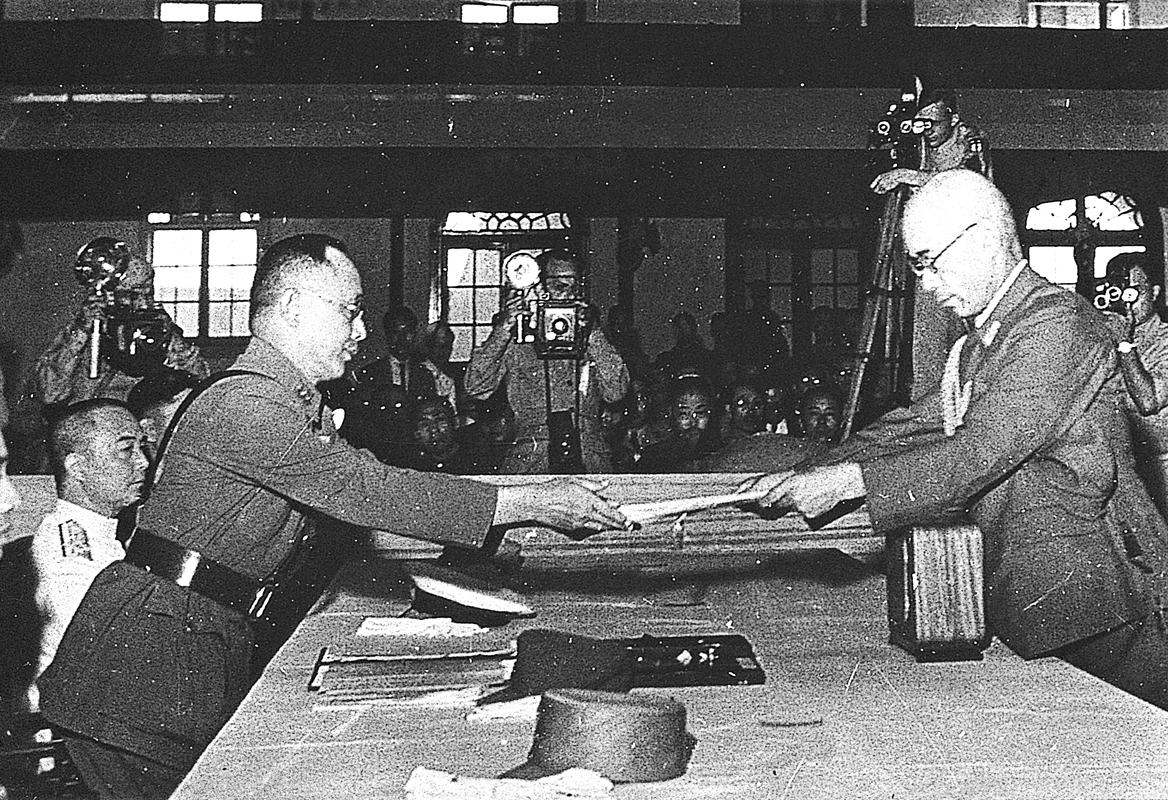The Axis powers’ ultimate defeat became obvious after the Allies’ sustained offensive. Italy and Germany already surrendered in October 1943 and 8 May 1945 respectively, marking the end of the World War II warfare in Europe. Furthermore, China’s counterattack on Japan was gaining momentum. From May to July 1945, the National Revolutionary Army (NRA) recovered the cities of Nanning (南寧), Liuzhou (柳州), Guilin (桂林), and eventually reclaimed Guangxi Province (廣西). The next step was to march on Guangzhou (廣州). That year, the United States also detonated two atomic bombs over the Japanese cities of Hiroshima and Nagasaki on 6 and 9 August respectively. On 9 August, the Soviet force entered Northeast China and broke down the 700,000-strong garrison of the Japanese Kwantung Army. By then, it was clear that Japan’s defeat was imminent.
On 15 August 1945 noon, the “Hirohito surrender broadcast” by the Japanese Emperor Hirohito aired nationally, announcing that Japan accepted the Potsdam Declaration issued by the United States, Britain, China, and the Soviet Union and surrendered unconditionally. China won the anti-Japanese war and World War II ended. At 10am on 2 September, Japanese representatives sign the Japanese Instrument of Surrender abroad the battleship USS Missouri BB-63 in Tokyo Bay. At 9am on 9 September in Nanjing (南京), the Nationalist government held a ceremony for Japan’s surrender in the China War Zone. Soon, the Nationalist government recovered Taiwan (Formosa, 台灣) and Penghu (the Pescadores, 澎湖) while Hong Kong returned to the British rule.
|
|
What were the implications of China’s War of Resistance Against Japanese Aggression? |
|
|
See answer below. |
In the later stages of the Pacific War, Japan’s eventual loss became inevitable. Left: the US B-29 Superfortress air bombing Osaka, Japan. Right: American forces capturing the Japanese island Iwo Jima.
The United States intensified its air raids on Japan towards the end of the Pacific War, causing tremendous losses to the Japanese economy and claiming more than a million civilian lives. It dealt a heavy blow on Japan’s wartime production and national morale. As for naval warfare, the Japanese Navy suffered from debacles since the defeat in the Battle of Midway in June 1942. Its destruction by the United States Navy was only a question of time. Also, the United States took hold of strategic points on the Pacific, including Saipan, Iwo Jima, and Okinawa, closing in on the Japanese mainland step by step.
Between March and June 1945, Japan launched the Battle of West Henan-North Hubei (豫西鄂北會戰) and the Battle of West Hunan (湘西會戰). Although the battles gave Japan control over Laohekou Airport (老河口機場), it came at a great cost. Meanwhile, Japan was routed in the Zhijiang (芷江) Campaign in Hunan Province (湖南). Left: wrecks of Japanese planes shot down in the Battle of West Hunan. Right: the NRA defending Zhijiang.
American forces were closing in on mainland Japan in early 1945. Therefore, Japan’s strategic objective for the Battle of West Henan-North Hubei and the Battle of West Hunan was to contain the United States’ bombings on the Japanese mainland by capturing its airfields in China. Another objective of the battles being maintaining Japan’s overground routes in China and winning the war with China as soon as possible to fortify the defence of its mainland. Japan launched the two battles in succession from March 1945.
Japan launched the Battle of West Henan-North Hubei in March to seize Laohekou in north Hubei Province (湖北), a land route hub with an airport. The Japanese force conquered west Henan Province (河南) and various parts of north Hubei before taking Laohekou on 8 April. However, the NRA soon struck back and recovered much lost ground except for Laohekou.
The Battle of West Hunan took place from 9 April to 7 June 1945 and involved 100,000 Japanese soldiers who attacked the Zhijiang air force base in west Hunan. The NRA mobilised 180,000 troops led by He Yingqin (何應欽), the Commander-in-Chief of the Army of the Republic of China, in response. The NRA won and killed over 30,000 enemy soldiers. The Battle of West Hunan was the last major battle in China’s War of Resistance, after which Japan’s operations in China ceased.
In April 1945, the NRA launched a counterattack in Guangxi. Nanning and Liuzhou were recovered on 27 May and 29 June respectively. Left: the NRA on patrol in the reclaimed Nanning in mid-June 1945. Right: Chinese and American soldiers raising national flags in the recovered Liuzhou in early August 1945.
On 27 July 1945, the NRA restored control over Guilin, Guangxi. The two photos above were taken in Guilin in August 1945. Left: the NRA passing the destructed head office of the Bank of Kwang-Si (Guangxi) in the newly recovered Guilin. Right: the NRA entering the ruins of downtown Guilin.
Left: On 6 August 1945, the United States detonating an atomic bomb over Hiroshima. Right: the bombed-out Hiroshima. On 9 August, the United States dropped another atomic bomb on Nagasaki. The bombings catalysed Japan’s surrender.
The Soviet forces entered Northeast China three days after the atomic bombing of Hiroshima on 9 August 1945. The Japanese Kwantung Army was routed in the face of the strong Soviet forces. The photo shows the Soviet infantry and tanks firing at the Japanese.
Left: On 15 August 1945, Emperor Hirohito announcing Japan’s unconditional surrender nationally through a broadcast. Right: Japanese civilians listening to the broadcast on their knees.
Left: Chiang Kai-shek (蔣介石) announcing Japan’s surrender in a national address on 15 August 1945. Right: Chinese people in the temporary capital of Chongqing (重慶) celebrating on the streets upon hearing of Japan’s surrender. Allied troops joined the celebration parade in their cars.
On 2 September 1945, a signing ceremony was held on the battleship USS Missouri BB-63 in Tokyo Bay where Japan signed the Japanese Instrument of Surrender. Left: Japanese Minister of Foreign Affairs Shigemitsu Mamoru (holding a cane), signed the Japanese Instrument of Surrender. Right: General Xu Yongchang (徐永昌), representing China, signed the instrument and accepted Japan’s surrender.
At 9am on 9 September 1945, a ceremony for Japan’s surrender in the China War Zone was held at the general headquarters of the Army of the Republic of China. Okamura Yasuji, the Commander-in-Chief of the China Expeditionary Army, signed the document. Kobayashi Asasaburo (right), the Chief-of-Staff of the China Expeditionary Army, handed the document on behalf of Okamura to the Commander-in-Chief of the Army of the Republic of China He Yingqin (left). Japan’s surrender marked the end of World War II. China achieved victory in the War of Resistance Against Japanese Aggression.
|
|
What were the implications of China’s War of Resistance Against Japanese Aggression? |
|
|
The war can be viewed from both international and national perspectives. Internationally, China made a significant contribution in the war. Among the Allies, China was the first to engage in anti-aggression war and its struggle lasted the longest. There is no question that Japan, Italy, and Germany, the three aggressors in World War II have traumatised humanity. The trio’s invasions of other countries started before World War II with Japan taking the lead. In the September 18th Incident in 1931, Japan invaded Northeast China and the Chinese rose to resist. In 1932 and 1933, intense battles broke out in Shanghai (上海) and along the Great Wall. Before the Pacific War, which broke out on 8 December 1941, China had already fought the Japanese single-handed for a decade. Although overwhelmed by Japan’s military power, the Chinese army broke down a considerable number of the enemy’s forces. Caught in the protracted war with China, Japan’s overall plan in World War II hampered. During the Pacific War, China sent a large number of expeditionary troops to Myanmar to aid British and American allies despite its own plight. The Chinese Expeditionary Force became a deciding factor in the Allies’ victory in Myanmar. Moreover, the China War Zone occupied a large amount of Japanese personnel and resources. In the Eight Years’ Total War of Resistance Against Japanese Aggression from 1937 to 1945, 40 Japanese senior commanders died. The NRA led by the Nationalist government killed 35 Japanese commanders, including two admirals, one general, eleven lieutenant generals, twenty major generals, and one rear admiral. The 8th Route Army and the New Fourth Army led by the Chinese Communist Party (中國共產黨) killed five Japanese commanders, including four lieutenant generals and one major general. Various records suggest that over 400,000 or 700,000 Japanese soldiers died on the battlefields in China, with Japan’s total casualties exceeding one million. Altogether more than one million Japanese soldiers joined the China Expeditionary Army and another 700,000 formed the Kwantung Army. As the China War Zone detained 60% of the Japanese ground force and a large sum of its air force and navy, Japan could not concentrate on fighting the United States and Britain. Although it was the United States that played a decisive role in Japan’s surrender, China’s contribution to the final victory of the war cannot be ignored. From China’s position, the war left an imprint on China’s military, public and international standing. First of all, the Chinese military showed courage, nobility, and a willingness to sacrifice in the War of Resistance. Before the war, Japan was a major world power and China’s military strength was no match for the former. Besides a shortage of munitions, China even lacked the most basic materials, such as sandbags. It seemed unlikely that China could survive an invasion from Japan. Therefore, Japan initially planned to take China in three months. The Chinese troops, however, had on their side huge manpower and strong patriotic sentiment. Therefore, China’s casualties were often several times more than that of Japan in the prolonged fighting. The Nationalist Government’s statistics showed that in the eight years of the full-out war, the two sides had 22 major battles, 1,117 combats and 38,931 smaller scale engagements where the NRA lost 200 officers above the rank of division commanders. 3,211,419 people in China’s ground force were killed, wounded or missing. The air force lost 4,321 personnel and 2,468 planes. The navy lost almost all of its warships. In many engagements, it was the NRA soldiers’ flesh and blood against the Japanese heavy fire, hence the wartime slogan “an inch of blood for an inch of territory”. In the end, the Chinese soldiers’ integrity lived up to the expectations of the nation. Second, there was the unyielding spirit of the Chinese people. The public supported the War of Resistance by various ways including working on production, fundraising, publishing war-time posters, and enlisting in the army. The war inflicted an estimation of 30 million Chinese casualties, although the exact number is hard to pin down. It was the people’ solidarity, fortitude, and sacrifice that sustained China’s defence until Japan’s surrender. The War of Resistance manifested the integrity of the Chinese nation. Third, China’s international status rose substantially. Since the mid-19th century, China’s overall strength and international standing had been on the decline. When China’s War of Resistance Against Japanese Aggression turned into a major sector of World War II, China became a key power of the Allies with growing international influence. During the war, China also attended international conferences such as the Cairo Conference. It negotiated with the Western powers to abolish the unequal treaties signed over the past century. After the war ended, China became one of the five permanent members of the United Nations Security Council. The War of Resistance Against Japanese Aggression was a turning point for China’s status in the international community. |
Source of most photos used in this feature piece: Fotoe and misc. photo sources.




